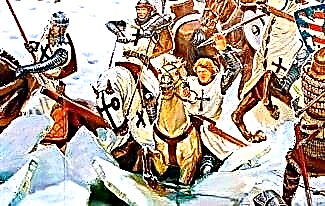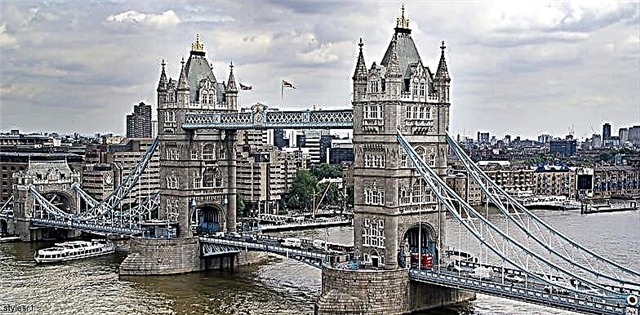Niccolo Paganini (1782-1840) - Italian virtuoso violinist, composer. He was the most famous violin virtuoso of his time, leaving his mark as one of the pillars of modern violin playing technique.
There are many interesting facts in Paganini's biography, which we will discuss in this article.
So, before you is a short biography of Niccolo Paganini.

Biography of Paganini
Niccolo Paganini was born on October 27, 1782 in the Italian city of Nice. He grew up and was brought up in a large family, where his parents were the third of 6 children.
The violinist's father, Antonio Paganini, worked as a loader, but later opened his own shop. Mother, Teresa Bocciardo, was involved in raising children and running a household.
Childhood and youth
Paganini was born prematurely and was a very sickly and weak child. When he was 5 years old, his father noticed his talent for music. As a result, the head of the family began to teach his son to play the mandolin, and then the violin.
According to Niccolo, his father always demanded discipline and a serious passion for music from him. When he did something wrong, Paganini Sr. punished him, which affected the boy's already poor health.
Soon, however, the child himself showed great interest in the violin. At that moment in his biography, he tried to find unknown combinations of notes and thereby surprise listeners.
Under the strict supervision of Antonia Paganini, Niccolo spent many hours a day rehearsing. Soon the boy was sent to study with the violinist Giovanni Cervetto.
By that time, Paganini had already composed many pieces of music, which he masterfully performed on the violin. When he was barely 8 years old, he presented his sonata. After 3 years, the young talent was regularly invited to play at services in local churches.
Later, Giacomo Costa spent six months studying Niccolo, thanks to which the violinist mastered the instrument even better.
Music
Paganini gave his first public concert in the summer of 1795. With the funds raised, the father planned to send his son to Parma to study with the famous virtuoso Alessandro Rolla. When the Marquis Gian Carlo di Negro heard him play, he helped the young man meet with Alessandro.
An interesting fact is that on the day when the father and son came to Rolla, he refused to accept them, because he did not feel well. Near the patient's bedroom, Niccolo saw the score of a concerto written by Alessandro, and a violin lying nearby.

Paganini took the instrument and played the entire concert flawlessly. Hearing the boy's fantastic play, Rolla felt a huge shock. When he finished playing to the end, the patient admitted that he could no longer teach him anything.
However, he recommended Niccolo to turn to Ferdinando Paer, who in turn introduced the prodigy to the cellist Gaspare Giretti. As a result, Giretti helped Paganini improve his game and achieve even greater skill.
At that time, Niccolo's biography, with the help of a mentor, created, using only pen and ink, "24 4-voice fugues".
At the end of 1796, the musician returned home, where, at the request of the touring Rodolphe Kreutzer, he performed the most complex pieces from sight. The famous violinist listened to Paganini with admiration, predicting his worldwide fame.
In 1800 Niccolo gave 2 concerts in Parma. Soon, the violinist's father started organizing concerts in various Italian cities. Not only people who understand music were eager to listen to Paganini, but also common people, as a result of which there were no empty seats at his concerts.
Niccolo has tirelessly refined his playing, using unusual chords and striving for accurate reproduction of sounds at the highest speed. The violinist practiced for many hours a day, sparing no time and effort.

Once, during a performance, the Italian's violin string snapped, but he continued playing with an imperturbable air, provoking thunderous applause from the audience. Interestingly, it was not new for him to play not only on 3, but also on 2, and even on one string!
At that time, Niccolo Paganini created 24 fantastic caprices that revolutionized violin music.
The virtuoso's hand touched the dry formulas of Locatelli, and the works acquired fresh and bright colors. No other musician has been able to do this. Each of the 24 capriccios sounded great.
Later, Niccolò decided to continue touring without his father, as he could no longer tolerate his tough demands. Intoxicated with freedom, he goes on long tours, which are accompanied by gambling and love affairs.
In 1804, Paganini returned to Gennaya, where he created 12 violin and guitar sonatas. Later, he again went to the Duchy of Felice Baciocchi, where he worked as a conductor and chamber pianist.
For 7 years, the musician served at the court, playing in front of high-ranking officials. By the time of his biography, he really wanted to change the situation, as a result of which he dared to take a decisive step.
To get rid of the bondage of the nobility, Niccolo came to the concert in the uniform of a captain, flatly refusing to change his clothes. For this reason, he was expelled by Eliza Bonaparte, Napoleon's older sister, from the palace.
After that, Paganini settled in Milan. At the Teatro alla Scala, he was so impressed by the dance of sorcerers that he wrote one of his most famous works, The Witches. He continued to tour various countries, gaining more and more popularity.
In 1821, the virtuoso's health deteriorated so much that he could no longer perform on stage. His treatment was taken over by Shiro Borda, who made bloodletting to the patient and rubbed in mercury ointment.
Niccolo Paganini was simultaneously tormented by fever, frequent cough, tuberculosis, rheumatism, and intestinal cramps.

Over time, the man's health began to improve, as a result of which he gave 5 concerts in Pavia and wrote about two dozen new works. Then he again went on tour in different countries, but now tickets for his concerts were much more expensive.
Thanks to this, Paganini became so rich that he acquired the title of baron, which was inherited.
An interesting fact is that at one time in the Masonic lodge of the Great East, the violinist sang a Masonic hymn, the author of which was himself. It is worth noting that the protocols of the lodge contain confirmation that Paganini was a member of it.
Personal life
Despite the fact that Niccolo was not handsome, he enjoyed success with women. In his youth, he had an affair with Elise Bonaparte, who brought him closer to the court and provided him with support.
It was then that Paganini wrote the famous 24 caprices, expressing in them a storm of emotions. These works still delight the audience.
After parting with Eliza, the guy met the tailor's daughter Angelina Kavanna, who came to his concert. The young people liked each other, after which they went on tour to Parma.
After a couple of months, the girl became pregnant, as a result of which Niccolo decided to send her to Genoa to visit relatives. Upon learning of her daughter's pregnancy, Angelina's father accused the musician of corrupting his beloved child and filed a lawsuit.
During the court proceedings, Angelina gave birth to a child who soon died. As a result, Paganini paid the appointed amount of money to the Cavanno family as compensation.

Then the 34-year-old virtuoso began an affair with the singer Antonia Bianchi, who was 12 years younger than him. Lovers often cheated on each other, which is why their relationship was difficult to call strong. In this union, the boy Achilles was born.
In 1828 Niccolò decides to part with Antonia, taking his 3-year-old son with him. To provide Achilles with a decent future, the musician continuously toured, demanding huge fees from the organizers.
Despite relations with many women, Paganini was attached only to Eleanor de Luca. Throughout his life, he periodically visited his beloved, who was ready to receive him at any moment.
Death
Endless concerts caused great harm to Paganini's health. And although he had a lot of money that allowed him to be treated by the best doctors, he did not manage to get rid of his ailments.
In the last months of his life, the man no longer left the house. His legs ached badly, and his illnesses did not respond to treatment. He was so weak that he could not even hold the bow. As a result, next to him lay a violin, the strings of which he simply fingered with his fingers.
Niccolo Paganini died on May 27, 1840 at the age of 57. He possessed a precious collection of Stradivari, Guarneri and Amati violins.
The musician bequeathed his favorite violin, the works of Guarneri, to his native city of Genoa, because he did not want anyone else to play it. After the death of the virtuoso, this violin was nicknamed "The Widow of Paganini".
Paganini Photos
















